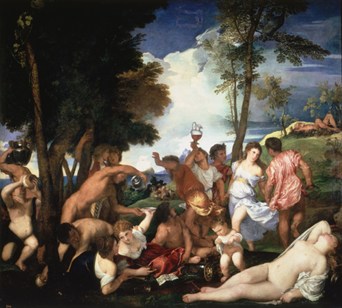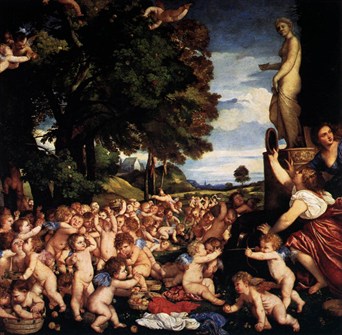Collecting between Italy and Spain: Titian’s Bacchanalia
 The Prado Museum in Madrid holds two masterpieces by Titian, the Bacchanalia at Andros (image 1) and The Worship of Venus (image 2), which the Count of Monterrey bought in 1633 from the collection which belonged to Cardinal Ludovico Ludovisi and was inherited by Nicolò Ludovisi. They ceded the precious paintings in order to obtain the Principality of Piombino from Philip IV of Spain. Executed by the Venetian master in the early twenties of the sixteenth century, the paintings were intended to decorate Alfonso I d’Este’s alabaster dressing room in via Coperta, a mythical place in the Ferrara of the Estense family. In the same room were the Feast of the gods by Giovanni Bellini (1514, Washington, National Gallery), Bacchus and Ariadne by Titian (London, National Gallery) and a painting by Dosso Dossi, on a Bacchic theme, which has been identified as the Triumph of Bacchus which today is in Mumbai, at the Prince of Wales Museum. The famous series of paintings, to be understood as one of the first sets of homogeneous decorative cycles based on mythological subjects, was inspired by ancient literary texts, by Philostratus’s Imagines, by the works of Catullus and Ovid, and was dedicated to the pleasures of wine and love; a celebration that, unlike the decorations in Mantua in the dressing room belonging to Alfonso I’s sister, Isabella d’Este, were free from any moralizing intent. For Titian myth is an opportunity to play with imagination and reflect on man and his destiny.
The Prado Museum in Madrid holds two masterpieces by Titian, the Bacchanalia at Andros (image 1) and The Worship of Venus (image 2), which the Count of Monterrey bought in 1633 from the collection which belonged to Cardinal Ludovico Ludovisi and was inherited by Nicolò Ludovisi. They ceded the precious paintings in order to obtain the Principality of Piombino from Philip IV of Spain. Executed by the Venetian master in the early twenties of the sixteenth century, the paintings were intended to decorate Alfonso I d’Este’s alabaster dressing room in via Coperta, a mythical place in the Ferrara of the Estense family. In the same room were the Feast of the gods by Giovanni Bellini (1514, Washington, National Gallery), Bacchus and Ariadne by Titian (London, National Gallery) and a painting by Dosso Dossi, on a Bacchic theme, which has been identified as the Triumph of Bacchus which today is in Mumbai, at the Prince of Wales Museum. The famous series of paintings, to be understood as one of the first sets of homogeneous decorative cycles based on mythological subjects, was inspired by ancient literary texts, by Philostratus’s Imagines, by the works of Catullus and Ovid, and was dedicated to the pleasures of wine and love; a celebration that, unlike the decorations in Mantua in the dressing room belonging to Alfonso I’s sister, Isabella d’Este, were free from any moralizing intent. For Titian myth is an opportunity to play with imagination and reflect on man and his destiny.
 Stolen in 1598 by Cardinal Pietro Aldobrandini at the time of devolution of Ferrara to the Holy See, the paintings entered the collection of the cardinal, and were donated in 1621 by Olimpia Aldobrandini, Pietro’s sister, to the nephew of Pope Gregory XV, Cardinal Ludovico Ludovisi. Several copies were made from the prestigious series, both during the period of their stay in the collection of Cardinal Pietro, and at the stage in which some of the paintings were in the Ludovisi collection, when the Spanish dignitary Monterrey acquired them. Among the first artists to reproduce famous paintings were Giuseppe Cesare called the “cavalier d’Arpino” (the gentleman from Arpino) and Alexander Varotari called the “Padovanino” (the Paduan) to whom we owe the most faithful replicas, executed when the originals were still with Olimpia Aldobrandini. Upon the transfer of The Worship of Venus and the Bacchanalia at Andros to the Spanish monarch, the Bolognese Domenichino was saddened by the loss of these masterpieces. These, as well as having inspired artists active in Rome between the twenties and thirties of the seventeenth century, such as Nicolas Poussin, François Duquesnoy and Pietro da Cortona, contributed to the birth of the Neo-Venetian style. Moreover, they continued to be copied even after their transfer to Spain, where they were exhibited in the palace and mentioned in inventories since 1666. Among the masters who best understood and were able to effectively reproduce the style of Titian, there was Pieter Paul Rubens, author of the copies of The Worship of Venus and the Bacchanalia at Andros (now in the Nationalmuseum, Stockholm), done after having admired and studied the originals during his diplomatic mission in Madrid in 1628-1629.
Stolen in 1598 by Cardinal Pietro Aldobrandini at the time of devolution of Ferrara to the Holy See, the paintings entered the collection of the cardinal, and were donated in 1621 by Olimpia Aldobrandini, Pietro’s sister, to the nephew of Pope Gregory XV, Cardinal Ludovico Ludovisi. Several copies were made from the prestigious series, both during the period of their stay in the collection of Cardinal Pietro, and at the stage in which some of the paintings were in the Ludovisi collection, when the Spanish dignitary Monterrey acquired them. Among the first artists to reproduce famous paintings were Giuseppe Cesare called the “cavalier d’Arpino” (the gentleman from Arpino) and Alexander Varotari called the “Padovanino” (the Paduan) to whom we owe the most faithful replicas, executed when the originals were still with Olimpia Aldobrandini. Upon the transfer of The Worship of Venus and the Bacchanalia at Andros to the Spanish monarch, the Bolognese Domenichino was saddened by the loss of these masterpieces. These, as well as having inspired artists active in Rome between the twenties and thirties of the seventeenth century, such as Nicolas Poussin, François Duquesnoy and Pietro da Cortona, contributed to the birth of the Neo-Venetian style. Moreover, they continued to be copied even after their transfer to Spain, where they were exhibited in the palace and mentioned in inventories since 1666. Among the masters who best understood and were able to effectively reproduce the style of Titian, there was Pieter Paul Rubens, author of the copies of The Worship of Venus and the Bacchanalia at Andros (now in the Nationalmuseum, Stockholm), done after having admired and studied the originals during his diplomatic mission in Madrid in 1628-1629.
